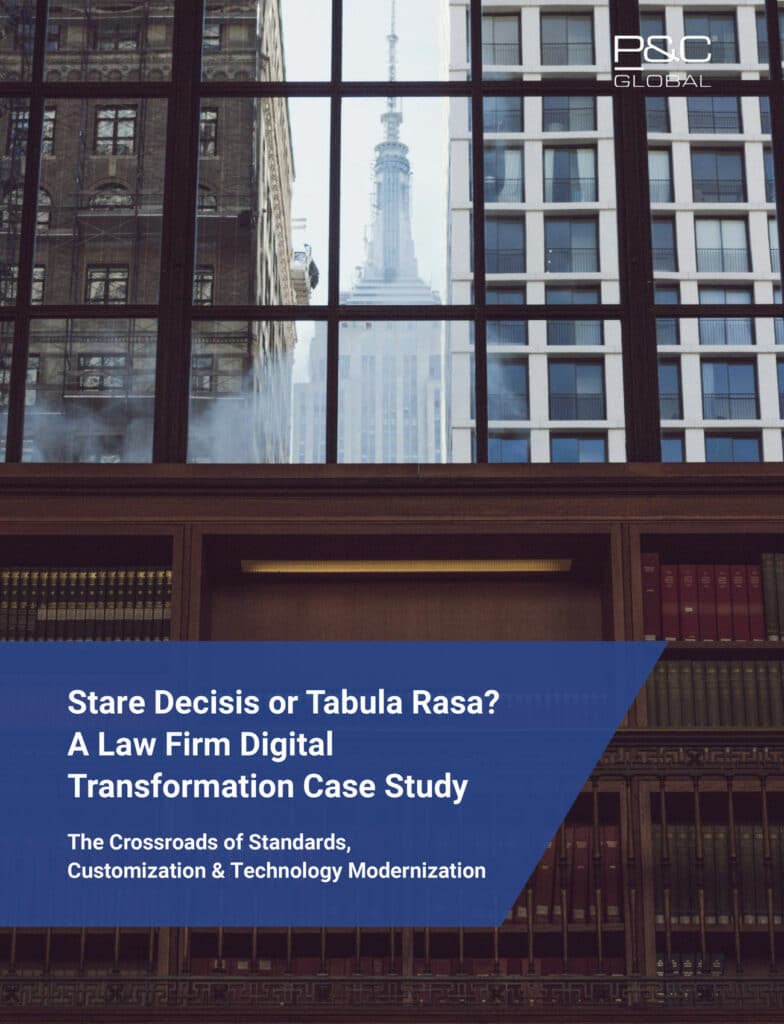Executive Summary: An AmLaw 200 Transformation
Over two decades, one of the nation’s most recognized plaintiff-side law firms invested more than $72 million in building and maintaining custom-built legal technology—financial and case management platforms—only to reach a point of near-total operational failure. The firm’s original system, developed in a now-obsolete programming language unsupported for over 15 years, cost $57 million and had become unmaintainable. A subsequent $15 million redevelopment effort—intended as its modern successor—ultimately delivered less than 20% usable functionality after 10 years of internal development.
This white paper presents a law firm digital transformation case study how a decisive strategic course correction, led by P&C Global, replaced two decades of legacy risk with a modern, standardized, and scalable platform architecture. Under extreme time pressure and escalating financial exposure, the firm partnered with P&C Global to exit its proprietary systems, restore operational control, and complete a full IT transformation anchored in proven Commercial-Off-The-Shelf (COTS) legal technology.
The engagement not only stabilized a failing infrastructure, but also unlocked sustainable efficiencies, improved financial controls, enforced stronger data governance, and reduced the firm’s cost of technology ownership by more than 70% over its prior trajectory.
For Managing Shareholders, CFOs, and CTOs navigating similar dilemmas, this case illustrates how firms can break the cycle of custom dependency, neutralize legacy risk, and embrace law firm technology modernization that supports agility, profitability, and growth.
Introduction: IT Health Check Reveals Legacy Risks in Law Firm
What began as a routine client referral for P&C Global quickly evolved into one of the most transformative law firm digital transformation engagements in recent memory. A top 10 U.S. bank, one of P&C Global’s long-standing clients and the law firm’s financial partner, recommended that we conduct a quick IT health check. It was framed as a courtesy review, prompted by the bank’s interest in exploring a new business opportunity with the firm.. The law firm, our new prospective client, assured us this would be simple. They had annual financial audits completed by a reputable national auditor. They had great software systems and business processes. Everything was under control.
It wasn’t.
Although our new law firm client was widely regarded as a leading practitioner within their field of law, this record of legal excellence did not extend to their administrative capability. P&C Global’s initial diagnostic uncovered deep-rooted deficiencies in the client’s back-office functions and enabling technology platform. At the heart of the issue was a sprawling, 30-year-old home-grown application responsible for accounting, case management, CRM, docketing, travel and expense reporting, and trust administration. Built without a long-term architectural vision, the system had grown into a brittle monolith—complex, undocumented, and dangerously out of step with modern requirements.
Business processes were not defined, and data governance was nonexistent. Meanwhile, the internal IT department—more than double the size and cost of peer firms—was chronically overstaffed, overpaid, and underutilized. Much of the team’s work had been quietly outsourced to third parties under the leadership of a part-time CTO, who received a full-time equivalent and market competitive compensation package but had little oversight and lacked accountability. Despite the instability, the organization was preparing to launch an untested “Version 2.0” of their bespoke platform. During the initial discovery phase, senior members of the law firm’s finance team discreetly reached out to P&C Global, urging us to halt the deployment.
The risks were acute. Core components of the application involved a programming language, integrations, and environment that had reached end-of-life 15 years ago and were now facing the end of “last resort” support within two years—yet the IT organization was completely unaware of this deadline. They faced an impending operational failure, with neither a transition plan nor mitigation strategy in place. Although an extreme case, their story reflects the challenges that many other law firms face as they make generational decisions to navigate the future.

Legal Sector in an Era of Digital Disruption
Law firms today stand at a unique inflection point. The practice of law is an ancient profession, stemming back millennia and tightly interwoven with the political, economic, and cultural development of societies spanning the globe. It is steeped in tradition and notions of consistency, with legal concepts such as stare decisis deeply ingrained in every lawyer.
As a quintessential part of the knowledge economy, however, law firms are experiencing an era of disruption unlike any they have previously encountered. The advent of digital capabilities is not just driving incremental efficiency improvements but completely reinventing the practice of law. Consider just how differently domains ranging from corporate transactions to litigation operate today compared to a generation ago given technologies including Generative AI, eDiscovery, and modern case management solutions. Newly minted associates, for example, would likely be shocked to learn that their senior partners performed M&A due diligence with paralegal teams tagging banker’s boxes of paper documents with Post-it notes. The pace of change is creating tabula rasa opportunities.
Managing Shareholder Pressure to Drive Law Firm Digital Innovation
With these tectonic forces above coming to a head, law firm leaders are now under inordinate pressure. On the one hand, they need to safeguard the precious trust, reputation, and brand equity that their firms have earned over the years across stakeholders including clients, legal talent, the judiciary, and regulatory bodies. At the same time, however, they must drive innovation that leverages emerging capabilities, seizes the initiative from fierce competitors, and drives ongoing client value.
Magnifying the challenge, the IT transformation of law firms that underpins much of this strategic innovation often falls outside the comfort zones of Managing Shareholders. After all, their typical passion is legal excellence rather than technology expertise. Although they can lean upon firm administrative leaders such as COOs and CIOs, as we describe below these personnel often have their own gaps and blind spots regarding true innovation.
This whitepaper is thus intended for Equity Partners and other law firm leaders confronting the strategic dilemma of how best to drive effective business and technical innovation. We begin by exploring a classic tension in digital transformation between best practice standard approaches and solutions versus Do-It-Yourself (DIY) custom development. We then describe various missteps law firms should beware when considering their approach, using illustrative examples from our case study client. Finally, we articulate a general approach that avoids the pitfalls, enables firms to capitalize upon what makes them truly unique, and thereby establishes the foundation for future success.
COTS vs. Custom: The Law Firm Technology Dilemma
Since the dawn of modern enterprise software development in the 1980s and 1990s, business and technology teams have recognized a fundamental trade-off between the benefits of standardization relative to customization. By following generally accepted industry practices and adopting basic industry solutions, organizations in any sector gain the benefit of collective wisdom. As fast followers, they can travel a safer path, allowing other players to bear the risk and cost of bleeding-edge development.
The trade-off, of course, is that approach potentially limits the organization’s ability to innovate. Especially for law firms who have demonstrated a record of legal excellence, it is tempting to seek to extend their advantage by building out a heavily customized set of business processes and supporting technology platform. At the extreme, this approach entails assembling a substantial in-house technology team, catering to an extensive wish list of end user requests, and developing a proprietary set of processes and digital solutions.
Which approach is correct? How should law firm leaders apply the resulting lessons to drive effective innovation in their organizations?
Why COTS Outperforms Custom in Law Firm Digital Transformation
The essence of successful business strategy across any industry, including law firms, is to clearly understand organizations’ core competencies and then rigorously focus upon them to develop competitive advantage. Every organization has limitations at some point, and it is crucial to determine the exact boundary.
Law firms often fall into the trap of assuming that an overall track record of successful client service implies that every facet of their operations is uniquely strong. For example, stronger practices and offices can inadvertently cross-subsidize others. In the realm of legal operations and supporting technology, firms frequently rely upon internal teams to embark upon heavily bespoke, long-term initiatives involving significant investments. These efforts can take a life of their own, spurred by personal fiefdoms, stakeholder conflicts of interest, and the lack of visibility into competitive best practices. Left unchecked, these programs involve a series of pitfalls that ultimately destroy value and expose firms to excessive risk.
Challenges of Building In-House Law Firm IT Expertise
Law firms pursuing a broad DIY approach to business process and technology innovation face an essential challenge assembling the requisite talent. Steady state technology administration and maintenance functions should be extremely lean. Many AmLaw 200 and global law firms operate IT departments with as few as seven to nine staff members, sometimes even fewer. These baseline resources are the opposite of the short-term surge in program resources typically needed to design and execute digital transformations. Once hired, bulky in-house teams and occasionally their firm, office, and practice sponsors have a natural incentive to try to perpetuate themselves, creating the danger of dramatically inflated overall lifecycle costs.
Our case study client exemplifies this point. At the outset, their IT department comprised 14 full-time employees. By contrast, their closest industry peer—similar in both revenues and attorney headcount— employed just five. Even with their bloat, however, the client had nowhere near the headcount of 67 people required to undertake a major DIY digital transformation program.
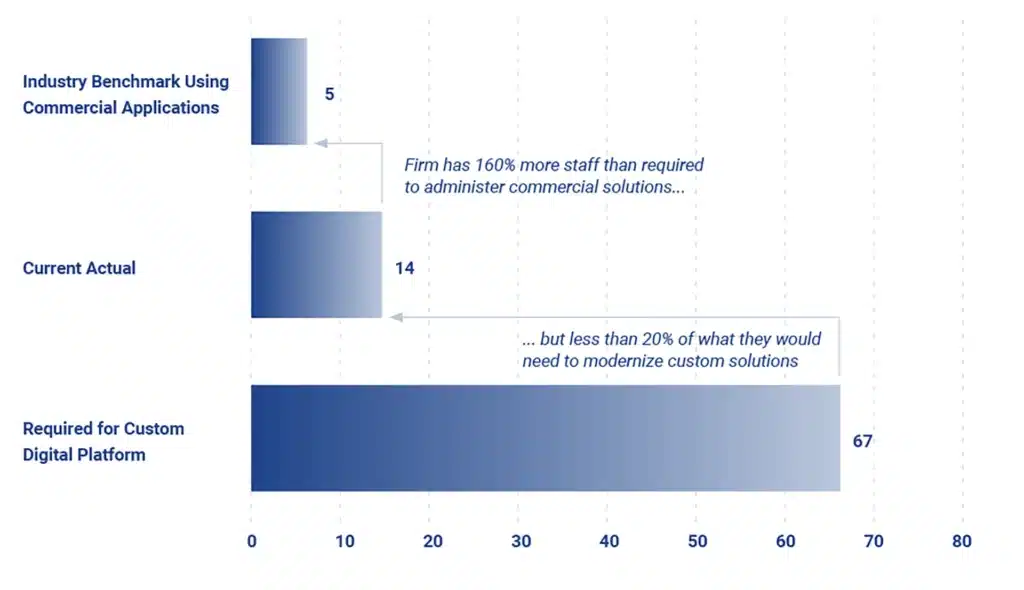
Exhibit #1 – Law firms relying upon custom software can suffer from bloated IT departments that are nonetheless incapable of pursuing next-generation custom solutions.
Another often-overlooked stumbling block with building proprietary digital transformation teams is the difficulty of attracting and retaining top-tier talent. From a recruiting perspective, ambitious candidates frequently dismiss law firm opportunities due to perceived long-term career path limitations. Even the eventual possibility of rising to a CTO role at a law firm with only one or two dozen IT personnel can pale in comparison with, for example, Silicon Valley or other corporate opportunities. Faced with marginal candidates, some firms amplify problems by failing to rigorously evaluate applicants, skipping even basic steps such as established minimum applicable education and thorough background checks.
When they initially approached us, our client faced overt skills deficits. The CFO who had overall responsibility for all administrative functions including Finance, Technology, Compliance and Risk, and Human Resources, had no technology background and largely avoided that domain entirely. Beyond contending with an ineffective, part-time CTO, half of their IT department including a critical Director role were known to be missing college degrees. Perhaps even worse, due to historically lax HR practices, they hired three core programmers and engineers who had misrepresented their credentials. Although their résumés listed undergraduate and/or graduate degrees and software development experience, our research proved that none of those claims were accurate. This team, not surprisingly, lacked cohesion, suffered from low morale, and made a series of basic blunders. For example, they skipped formalized test protocols within their software development cycles, and, in fact, lacked functional development, test, or staging environments upon which they could perform foundational software development tasks. Unfortunately, this situation is not unusual. We have seen similar examples at other law firms where IT personnel who had misrepresented their credentials drove disastrous outcomes for their employers.
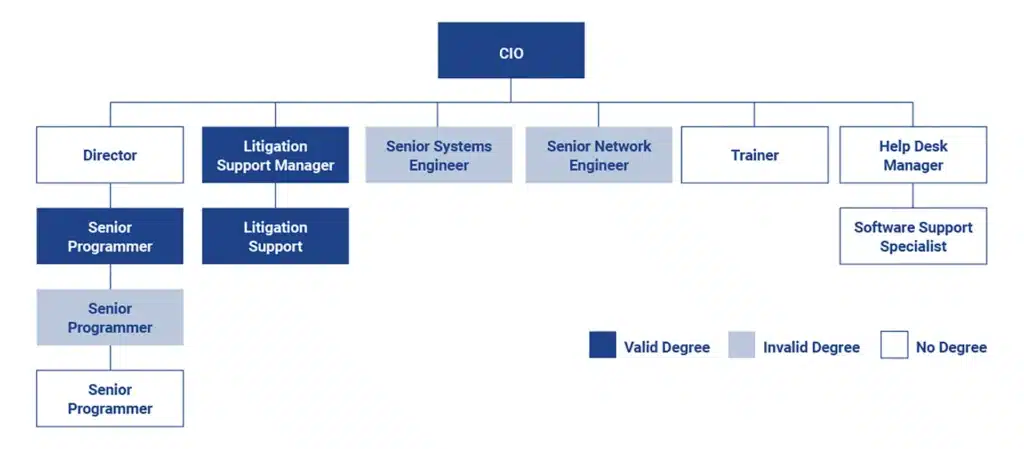
Exhibit #2 –Absent rigorous recruiting and vetting, legal IT departments often have substantial skill gaps.
Lack of Legal Operations Process Discipline
Absent the grounding of industry-standard approaches and solutions, law firms can find themselves reinventing the wheel in defining common processes or identifying suboptimal approaches. Especially in cases where administrative staff have extremely long tenures at a given firm, they can lack the external exposure to understand industry best practices. Even worse, firms can fall into the trap of abdicating process discipline altogether, allowing end users almost total freedom to define their own approaches.
The client’s legacy invoice approval process, for example, relied on vague guidelines that were often overridden by exceptions and the discretion of individual attorneys—including Associates and even Legal Assistants—who imposed their own invoicing formats and norms.
Approval thresholds nominally existed but were often disregarded, with personnel empowered to use judgment rather than follow consistent protocols. Overlapping authorities and informal exceptions created confusion, reduced accountability, and increased operational risk. This, in turn, made it virtually impossible to monitor, streamline, or automate the process.
Poor Data Governance in Developing Law Firm Technology
Gaps in process discipline often lead to lax record-keeping. Law firms pursuing DIY software development lack typical data-quality safeguards such as real-time validation rules and error-handling workflows that come standard with modern enterprise applications. Validation rules, for instance, enforce consistency checks—such as requiring that invoice line items equal the invoice total. These safeguards reflect industry standards for built-in data governance and compliance with U.S. and international requirements. Without them, law firms must establish their own governance structures: decision-making rights, policies, protocols, and controls to actively manage data quality.
Our client’s initial crisis was unfortunately compounded by decades of inadequate attention to all these issues. Across nearly 100 million records spanning critical domains such as accounts payable and trust administration, they experienced almost a 48% error rate—virtually every other record was incorrect. For example, basic reports showed discrepancies in calculated trust balances totaling hundreds of millions of dollars. Stemming from a combination of factors including inadequate day-today discipline and multiple mismanaged prior data conversions, they faced more than 200 unique sets of validation rule violations, each of which needed to be individually investigated and addressed. These significant gaps not only clouded visibility into operational results, threatened financial integrity, and precluded quick remediation, but also stalled the firm’s broader law firm digital transformation agenda. Lacking strong data governance and technology modernization practices, the firm was unable to advance meaningful IT transformation or achieve the operational efficiency gains critical to long-term law firm operations transformation.
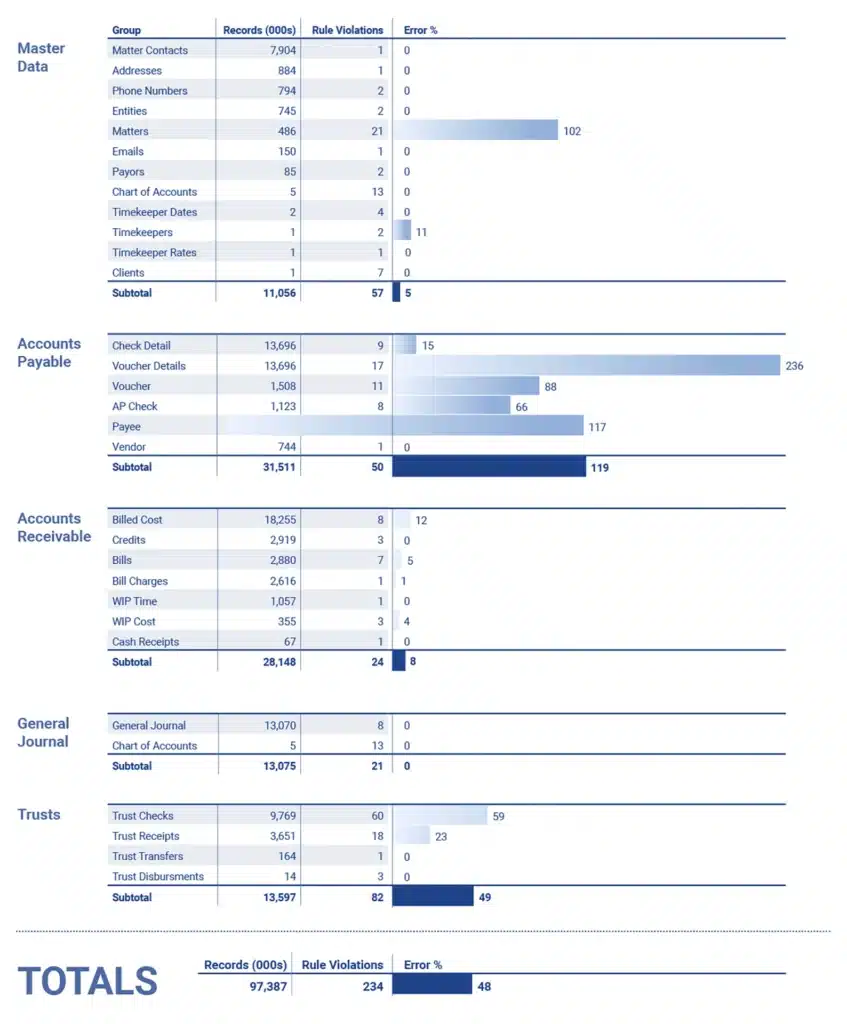
Exhibit #3 –Lax data governance and stewardship can create a data quality nightmare
Cost-Prohibitive Law Firm Technology Development Economics
Another downside of custom development is that it almost always proves to be more expensive than implementing corresponding industry-standard packages from major software vendors, so-called COTS solutions. The reason for this is simple: major software vendors including those in the legal industry such as Elite and Aderant can amortize their design, development, maintenance, and support costs across a broad customer base. Even factoring in additional costs such as marketing and sales along with profit margins, they are typically able to pass along significant savings to their clients.
For our client, this translated into an enormous cost differential between the two approaches. To begin, one-time implementation costs were significantly less expensive for the COTS solution than its custom alternative, which would alone save the firm millions of dollars. The primary difference, however, stemmed from recurring costs, where the substantial in-house resources required for ongoing maintenance and development of a custom solution would be tens of millions of dollars more expensive. When evaluated on a total cost of ownership basis—considering all costs over the full solution lifecycle—a custom solution involved more than quadruple the cost.
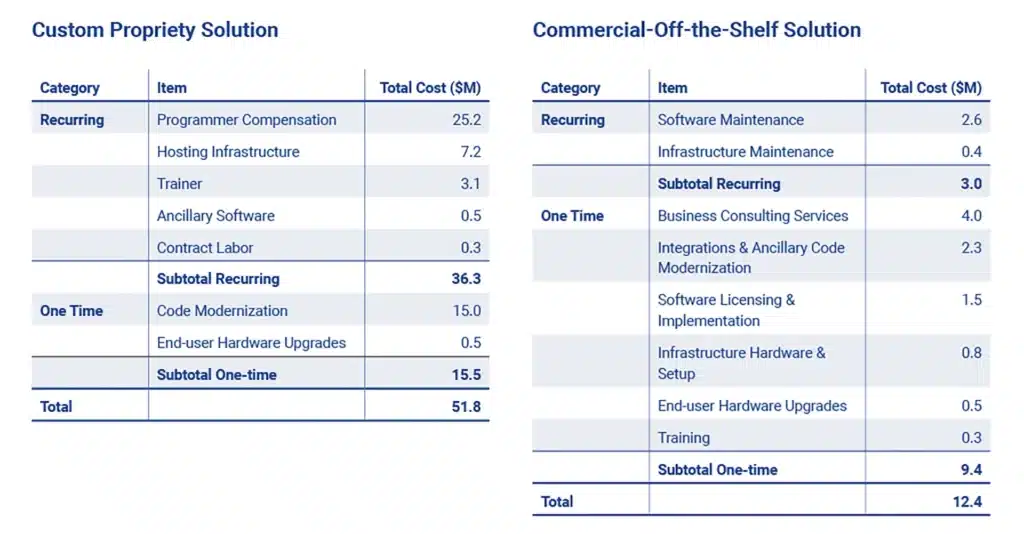
Exhibit #4 –Custom proprietary solutions can cost more than quadruple their commercial counterparts
Cybersecurity Risks in Legacy Law Firm Systems
One might think that the increased costs often associated with DIY approaches at least come with the silver lining of enhanced security. Surely, the extra staff required to maintain custom technology stacks bring an extra level of vigilance in mitigating risk. In fact, quite the opposite can often be true. Although larger than at peer organizations, IT departments managing custom solutions still generally pale in comparison to commercial vendors. Moreover, considering the skill gaps often found on these teams, they can make dangerous mistakes.
As part of our initial IT health check with the client, we immediately identified a series of critical deficiencies raising cybersecurity concerns and involving various forms of waste. For example, the firm had failed to deactivate the security credentials of over 300 previously terminated employees. Imagine the damage that could be caused by just a single disgruntled former employee who chose to abuse their inadvertent ongoing access. In an era where law firms are increasingly being targeted by hackers seeking troves of valuable information, other vulnerabilities such as unsecured network firewalls similarly required urgent attention. In today’s environment of escalating cybersecurity risks to law firms, outdated legacy systems without modern safeguards amplify both operational and compliance risks. These vulnerabilities highlight why law firm IT transformation must be a critical component of every digital transformation strategy.
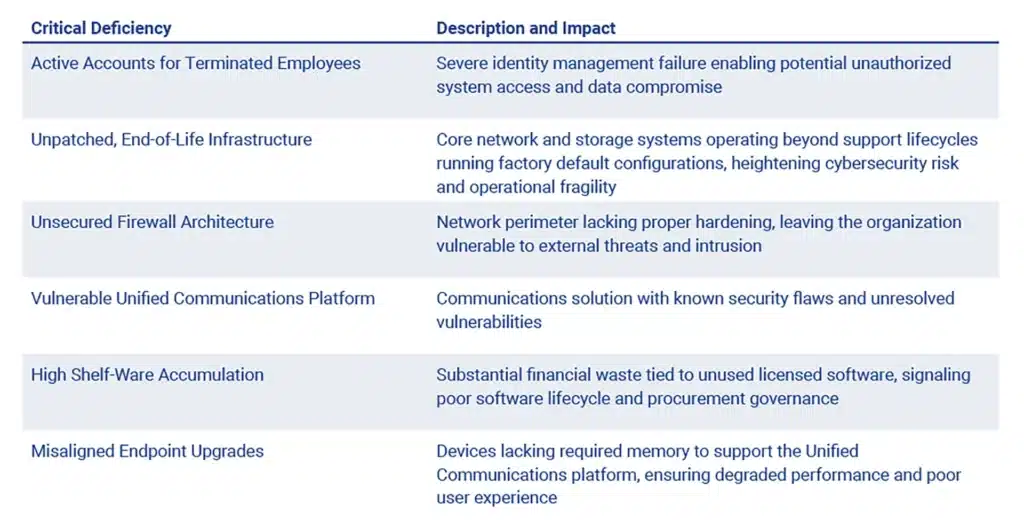
Exhibit #5 –Excessive reliance upon in-house resources can escalate risk and waste resources.
The pitfalls of straying from industry best practices are not limited to the technology domain. For example, many U.S. law firms are confronted with ongoing cost pressures stemming from employee benefits programs, notably including health insurance. Here, two important considerations apply.
The first is whether or not to self-insure as a firm, either purchasing coverage from a health insurer or engaging a third-party administrator to process claims on the firm’s behalf. Second is the notion of consumerism—injecting economic incentives into plan design to raise some level of consciousness among plan participants regarding the consequences of their choices. It would be wasteful, for example, for someone with a minor injury to seek out the top orthopedic surgeon in their city. One way that employers accomplish this is by favoring so-called Consumer-Driven Health Plans (CDHPs) over Preferred Provider Organizations (PPOs), enabling participants to manage and pay for their healthcare costs.
Industry best practices here are clear. For firms with fewer than 250 employees, especially those such as our client with a significant proportion of employees over 45 years old, the risks of selfinsuring and being exposed to catastrophic claims drive the majority to purchase health insurance coverage. Moreover, 80% of these peer organizations choose to adopt CDHP plans in order to promote consumerism. Despite this strong precedent, our client had succumbed to momentum and maintained an expensive, self-insured PPO plan without any caps on costs in key claims areas.. To make matters worse, the client’s Third-Party Administrator (TPA) had its remuneration based on 20% of all claim costs, so higher claims meant that they also had to pay higher administration fees. Spurning these industry best practices—thereby absorbing catastrophic claims and failing to “bend the curve” of expense escalation through consumerism—would cost the firm an incremental $5 million over the following decade.
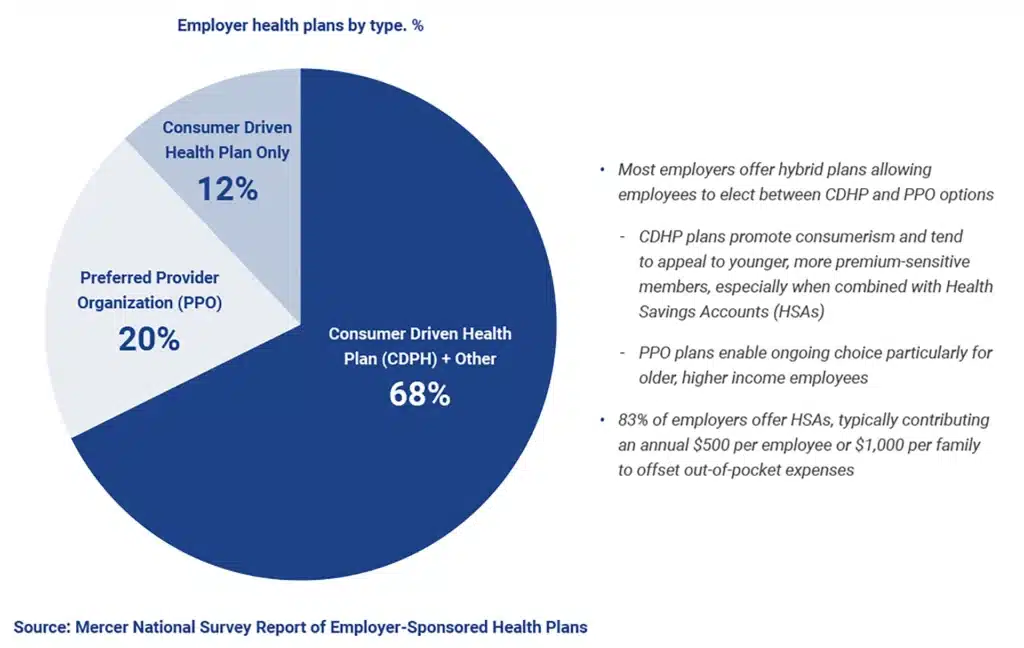
Exhibit #6 –Deviation from industry standards in domains beyond technology, such as retention of PPO plans for health care benefits, can also expose firms to avoidable cost pressure and risk.
Cultural Resistance to Law Firm Digital Transformation
The final major pitfall of the DIY approach is perhaps the most insidious. Whereas industry-standard approaches and solutions inherently force organizations to maintain contact with their peers, competitors, and other key entities such as vendors, they can become insular and siloed when pursuing go-it-alone custom solutions.
Absent robust interaction outside their organization, their personnel can fall victim to the so-called Dunning-Kruger effect. This concept, drawn from the fields of cognitive and organizational psychology, posits that low-skill individuals can dramatically overestimate their capabilities. Essentially, they are not aware of what they don’t know. This phenomenon, moreover, can be quite infectious, causing work teams or even entire organizations to become overconfident. This, in turn, leads to persistently poor decisions.
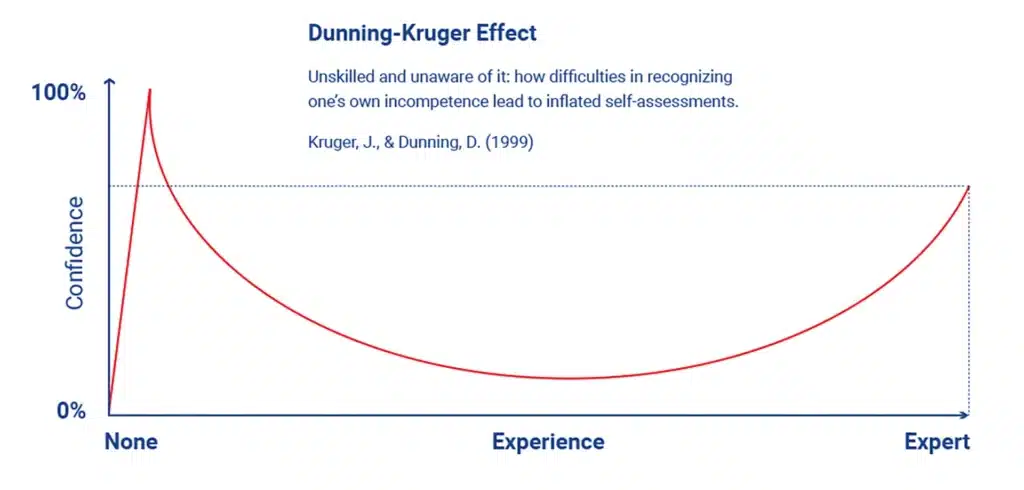
Exhibit #7 – Isolated organizations and teams can fall prey to not knowing what they don’t know.
Unfortunately, our client was significantly impacted by this cultural complacency, which manifested as an extreme resistance to more effective, modern approaches. They hesitated, for example, to transition from a firm-paid to individually-paid corporate credit card program for traveling employees, which would provide a natural incentive for them to submit timely and accurate expense reports to seek reimbursement. Similarly, they clung to email-based approval of accounts payable invoices rather than streamlined digital workflows enabled by a new COTS application. This ingrained resistance slowed the adoption of law firm digital transformation best practices and stalled the firm’s ability to modernize. Overcoming resistance is critical: without cultural alignment, even the most sophisticated IT transformation projects fail.
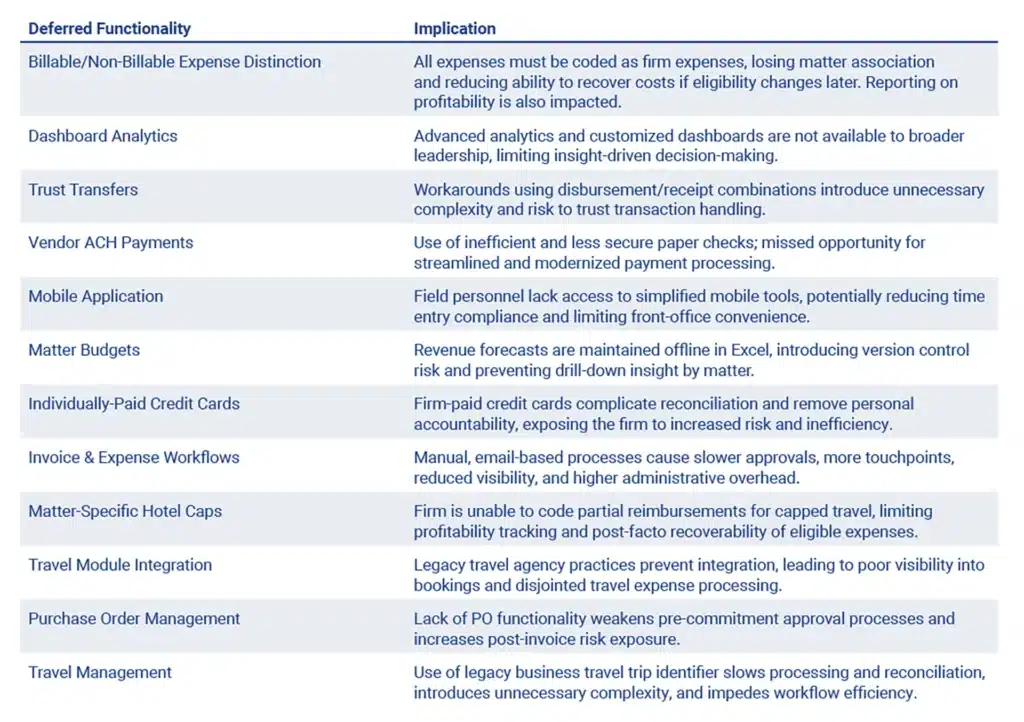
Exhibit #8 – Change resistance can lead to a myriad of missed opportunities
The Path Forward: Targeted Legal Innovation
Faced with these potentially daunting challenges, how then should Managing Shareholders chart their path forward? Rather than leaping into seemingly appealing opportunities as they arise, the answer as always is to ground decisions in foundational business strategy.
In particular, identify the critical few core competencies where the firm is truly unique and then distinguish the typically more extensive set of domains where standard industry best practices will suffice. For example, an insurance defense firm may decide that their long-term business model hinges upon a proprietary set of lean law firm operations, a strong and centralized practice management function, and enabling capabilities. By contrast, very few law firms require truly unique accounts payable approaches—tried and true industry standard workflows and industry standard, commercially available software tools long in place across many different industries, including law firms, are perfectly acceptable.
Once business strategy is in place, the corresponding technology strategy should follow naturally.
Build a Solid Base Using Commercial-Off-The-Shelf Solutions
For the majority of domains where industry best practices will suffice, law firms should seek to adopt thoughtfully configured standard enterprise workflows and solutions. Depending upon the specific firm, this could include practice management, case management, Client Relationship Management (CRM), document management, eDiscovery, and Human Resources Information Systems (HRIS). As noted above, by achieving economies of scale across a portfolio of clients, large solution providers in each area can amortize their development and maintenance costs, pass along savings to licensees, and simultaneously invest in cutting-edge research and development. These COTS solution providers also reflect best practice workflows, providing a solid starting point for law firms less familiar with modern approaches.
Strategic Customization for Law Firm Advantage
By contrast, those focus areas where a firm chooses to effectively “double-down” on truly unique capabilities and opportunities merit corresponding bespoke approaches. Based upon the business context and key objectives, this typically involves the articulation of a phased development roadmap, iterative design of proprietary workflows, custom development of enabling technologies, and white glove change management processes. Here, trusted partners are essential to ensure success, bringing both the domain expertise and implementation muscle to deliver success.
From Crisis to Confidence: What P&C Global Delivered
Stabilizing Capabilities and Mitigating Legal Tech Risk
P&C Global moved swiftly. To fully illuminate the landscape of challenges, we performed a rapid but thorough discovery process. This entailed detailed interviews with a cross-section of legal and administrative staff across all departments and offices, process mapping of core workflows, and technical assessment of their monolithic legacy application.
Our near-term priorities focused on stabilization and risk containment. Regarding the organization, we installed an interim CTO from our firm to stabilize leadership and bring immediate accountability. We led the sourcing, hiring, and onboarding of both a permanent CTO and new HR Director, while also designing a competitive compensation plan and targeted staff retention framework to support longer-term transformation.
Given its significant security gaps and outdated infrastructure, technology modernization was an urgent priority. We strengthened access controls with multi-factor authentication and account deactivation for terminated staff, established reliable backup and recovery processes, and refreshed aging network hardware that had gone unpatched since 2017. In parallel, we rolled out enterprisewide malware protection, upgraded endpoint devices to support modern applications, and deployed a secure unified communications platform. Together, these measures hardened the client’s network, instituted baseline security practices, and provided a stable, modern foundation for operations.
In parallel, the client asked us to review their insurance portfolio including employee benefits, overall professional liability, and property & casualty coverage. We thus performed a comprehensive review, optimizing plan designs, coverage lines, and coverage amounts based upon industry benchmarks. We then remarketed those policies to achieve significant premium reductions.
Charting the Strategy & Roadmap for Law Firm Technology Modernization
Having resolved the urgent issues, we collaborated closely with the Managing Shareholder group to crystalize their vision for the firm, addressing topics such as the expected evolution of their practice mix and corresponding implications for key required capabilities. To ensure critical leadership alignment, we helped navigate complications such as divergent interests across different practices and leadership succession considerations.
We then developed a phased digital transformation roadmap built around a COTS strategy, including vendor evaluation, product selection, and organizational realignment to support sustainable operations at a lower cost structure. The evaluation followed a structured screening process, where we applied objective criteria to assess candidate solutions including Elite 3E, Elite ProLaw, Aderant Expert, Aderant Expert Case, Aderant Compulaw, SAP Fulcrum, Juris by Lexis Nexis, Clio, Intapp, Oracle NetSuite, Litify, Emburse Enterprise, and Cosine Solutions. Ultimately, we identified a combination of Elite 3E and Emburse Enterprise as an integrated package of solutions that represented the best fit for the client’s needs. P&C Global’s phased law firm digital transformation roadmap, anchored in industry-standard COTS legal technology solutions, ensured long-term sustainability, cost efficiency, and measurable improvements in both law firm operations and IT performance.
Delivering an Integrated Digital Transformation
With the strategy in place, we turned to execute the transformation program. Implementation spanned 20 months but was no ordinary lift. Decades of unregulated business processes, undocumented development, and poor data hygiene combined with multiple acquisitions lacking standardized integration protocols, had created substantial technical debt.
Data migration and remediation alone accounted for two-thirds of overall level of effort, requiring multiple extended onsite workshops with teams of business and technology staff to iteratively profile data sets, identify errors, determine root causes, and then correct millions of records. To drive process discipline, we conducted cross-functional business process design sessions articulating a single unified set of agreed workflows. In parallel, we facilitated a structured set of requirementsgathering events to inform solution configuration, addressed a short exception list of customization requirements, and conducted iterative rounds of end user testing. As overarching program manager, we seamlessly coordinated resources across seven different organizations to bring the project to fruition.
Given the client organization’s persistent underestimation of its own complexity—a textbook case of the Dunning-Kruger effect—we paid particular attention to change management. Building upon the support of the firm’s senior leaders, we established a transformation taskforce, a cross-functional coalition of client employees who were well regarded by colleagues as domain experts within their respective areas. In addition to informing system configuration and data remediation, they served as change champions, advocating for the new processes and solution as the program approached go-live. We also designed and executed a comprehensive communications campaign and collaborated with the client regarding training strategy.
The implementation program overcame the client’s initial obstacles and culminated with the successful go-live of their modern, integrated COTS solution. Their legal and back-office staff are now consistently executing modern, streamlined processes on a robust and scalable technology platform. They are now also equipped with a foundation of clean data, tools and documentation such as ongoing data validation routines and data dictionaries, a secure infrastructure, new unified communications, and a significantly more robust administrative leadership team.
These accomplishments are now serving as the springboard for the client’s next phase of innovation, which will focus upon case management for their unique mix of practice requirements. They have averted a crisis, secured the present, and established the foundation for their next chapter of pioneering legal work.
Conclusion: Safeguarding the Future of Legal Excellence
This law firm digital transformation case study demonstrates the considerations that leaders face when navigating disruption and innovation. It also illustrates P&C Global’s ability to pivot from tactical triage to strategic digital transformation—helping law firms future-proof operations, safeguard excellence, and embrace profitable innovation. What began as a quick check-up became a full-scale rescue and rebuild—delivered with urgency, clarity, and measurable impact.
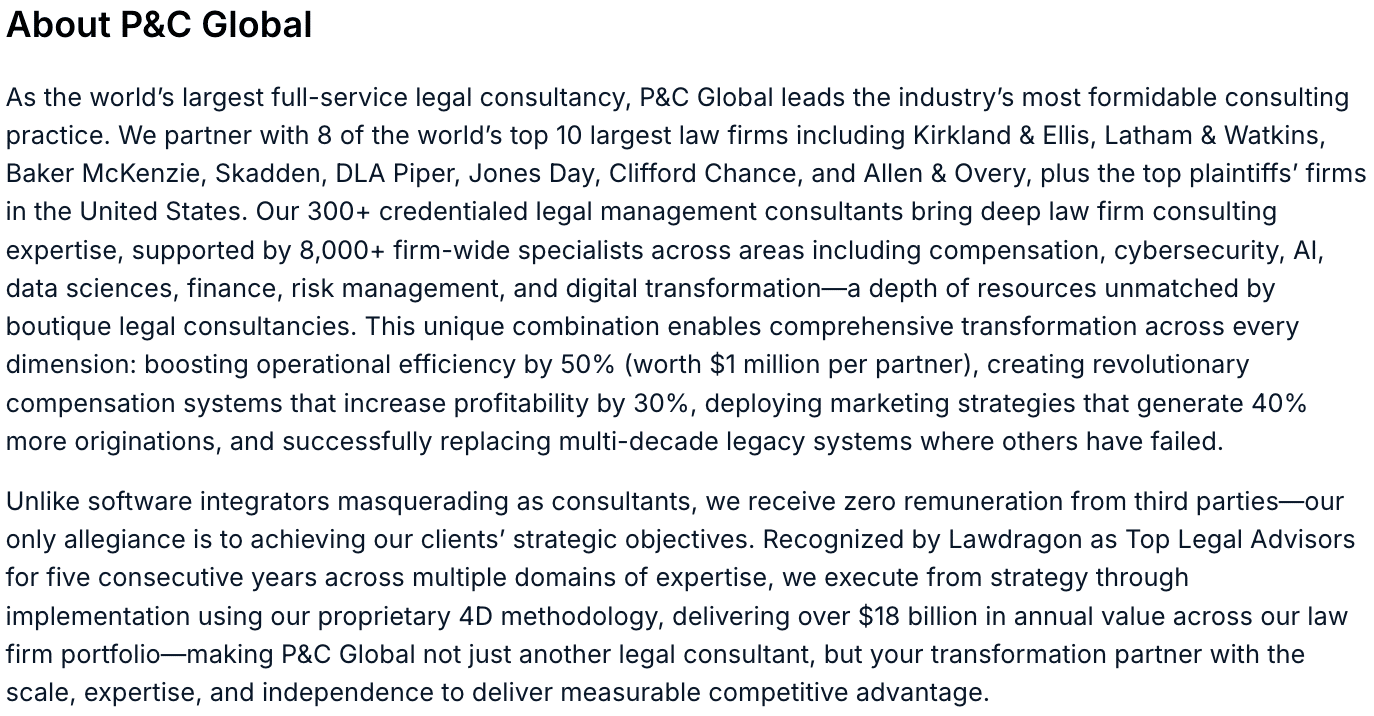
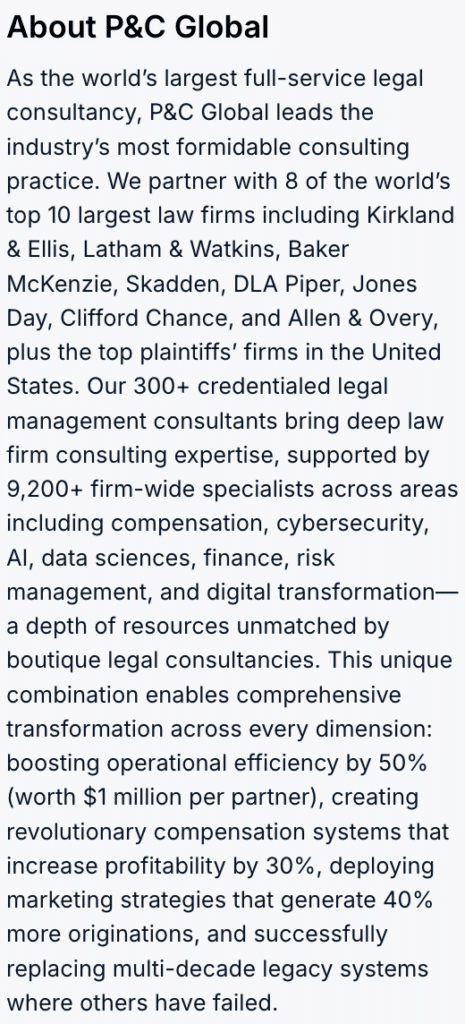
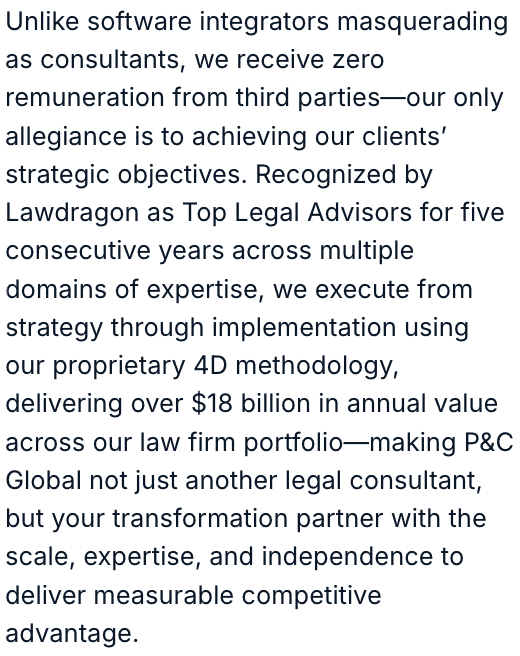
Glossary
ACH Payment: An electronic funds transfer through the Automated Clearing House (ACH) system, often used for vendor payments as a secure alternative to checks.
AmLaw 200: Annual ranking of the 200 largest U.S. law firms by revenue; used as a peer reference point for scale and benchmarks in the case study.
Case Management: Coordinated process of organizing, tracking, and handling all aspects of a legal matter—from deadlines and documents to client communications and court filings—to ensure efficiency, compliance, and effective client representation; often involves structured procedures and specialized software to streamline workflow and improve outcomes.
Change Management: A structured approach to guide people through process/technology transitions via communications, training, and champions.
Commercial-Off-The-Shelf (COTS): Commercially available, vendor-supported software configured (not custom-built) to fit firm workflows; emphasized as the preferred foundation for stability, lower TCO, and best-practice processes.
Consumer-Driven Health Plan (CDHP): A benefits design that encourages cost-aware choices, often paired with HSAs/HRAs to reduce premium growth.
Client Relationship Management (CRM): A set of processes and system that law firms use to manage interactions with clients and prospective clients. CRM platforms track contact details, relationships, referrals, business development activities, and client history. They help firms improve client service, retain relationships, generate new matters, and assess the health of client engagements.
Custom/Proprietary Solution: An internally built system tailored to a firm’s unique requirements; often costly to build and maintain, fragile over time, and dependent on scarce in-house talent.
Data Governance: Policies, roles, standards, and controls for managing data assets to ensure quality, integrity, security, and compliance.
Data Migration: Extracting, transforming, cleansing, and loading legacy data into a new system; depending upon initial data quality, it can often be the largest component of overall level of effort within digital transformation programs.
Dunning-Kruger Effect: Cognitive bias where low-skill individuals overestimate their competence, leading to overconfidence and poor decisions.
eDiscovery: Identification, preservation, collection, review, and production of electronically stored information for legal proceedings.
Elite 3E: A financial and practice management platform developed by Elite.
Emburse Enterprise: An expense and accounts payable automation platform.
Endpoint: A user device (desktop, laptop, mobile) that connects to firm networks; requires patching, configuration, and monitoring to mitigate risk.
End-of-Life (EOL): A vendor-announced end of support for a technology/product. Operating on EOL technology stacks heightens operational and security risk.
Firewall: A network security system that monitors and controls traffic, forming a barrier between trusted and untrusted networks.
Generative AI: Artificial intelligence models capable of producing human-like text, images, code, or analysis; increasingly applied in legal research, drafting, and discovery.
Go-Live: The point at which a new system becomes the firm’s system of record for production use.
Health Reimbursement Arrangement (HRA): An employer-funded health benefit account that reimburses employees for qualified medical expenses. Unlike HSAs (which are employee-owned, tax-advantaged savings accounts paired with high-deductible health plans), HRAs are fully funded and controlled by the employer, cannot be taken by employees when they leave, and do not require employees to carry a high-deductible plan. They are often paired with Consumer-Driven Health Plans (CDHPs) as a flexible benefit design.
Health Savings Account (HSA): A tax-advantaged account paired with CDHP plans allowing employees to save and pay for qualified medical expenses.
Human Resources Information System (HRIS): A platform for managing HR functions including payroll, benefits, recruiting, and compliance.
Legacy System: An older or obsolete application or technology still in use (often monolithic and undocumented) that is out of step with current requirements.
Malware: Malicious software (viruses, ransomware, spyware, etc.) that disrupts, damages, or gains unauthorized access to systems.
Monolithic Application: A single, tightly-coupled system handling many functions (e.g., accounting, CRM, docketing), making changes risky and slow.
Multi-Factor Authentication (MFA): Access control requiring two or more forms of verification to reduce account takeover risk.
Practice Management: Administration of the business facets of legal services, including client intake, billing, time tracking, scheduling, document management, and compliance; focuses on optimizing firm operations and resources so attorneys can deliver legal work efficiently and profitably.
Preferred Provider Organization (PPO): Flexible health plan with broad provider choice but typically higher premiums/cost-share for employers.
Self-Insured Benefits: Medical and other employee benefit programs where the employer pays claims directly (as processed by a TPA) rather than paying insurance premiums; exposes smaller firms and those with older employees to catastrophic-claim risk.
Shelf-Ware: Purchased software that is left unused, signaling procurement and lifecycle management issues and avoidable spend.
Subject Matter Experts (SMEs): Individuals within a law firm or organization who possess deep expertise in a particular domain such as finance or case management. In transformation programs, SMEs contribute to requirements gathering, process design, and solution configuration. They also act as trusted voices to colleagues, often serving as change champions to drive adoption of new systems and workflows.
Third-Party Administrator (TPA): A vendor that administers self-insured health plans; fees may be tied to claims volume.
Total Cost of Ownership (TCO): All-in cost over a system’s lifecycle (implementation, licensing, infrastructure, support, upgrades, personnel); used to compare alternative approaches including COTS versus custom development.
Transformation Taskforce: Cross-functional cohort of respected firm SMEs who inform configuration and act as change champions.
